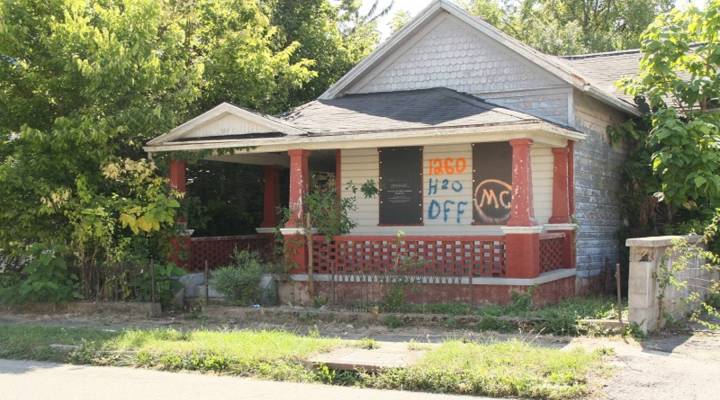
In Dayton, empty homes hurt recovery

We’ve been hearing plenty lately about skyrocketing real estate in San Francisco and New York. But these booming markets are a long way from reality in places like Dayton, Ohio — a small city that still hasn’t recovered from the foreclosure crisis.
The city has focused on re-energizing its downtown, but lots of the outlying areas have been overlooked. In one historic Dayton neighborhood, Wolf Creek, just west of downtown, more than a quarter of the houses are still empty.
“You can live in Dayton proper and never ever see this,” Dayton resident Joel Jones said, as we drove about five minutes from downtown, although she said, mentally, it was further than that. “Unless you’re coming to visit someone, what reason would you have to come over? There’s no stores. There’s no auto center, there’s no dry cleaners. The only thing you’re gonna get is chicken and hamburgers.”
This used to be a thriving area, but after decades of job and population loss, the Great Recession hit — and thousands of homes in Dayton were foreclosed and ended up bank-owned, or owned by absentee landlords. A group of community advocates that wants more attention paid to their neighborhood took me on a tour.
Shenise Turner-Sloss acted as a guide, while Jamica Garrison drove a white SUV.
“We have a burn-out, which obviously has been sitting for years,” Turner-Sloss said, pointing to a house with walls stained black from a recent fire. “There’s no caution tape.”
She said homes like this can become hazardous and attract crime.
One demolition in West Dayton was started, but never finished. This pile of rubble sits unmarked, on a block full of vacant three-story homes.
Further north, we passed by a big boarded-up house that wasn’t actually empty — I noticed a gold car with glinting hubcaps outside.
“I don’t think they’re in there making a pot roast,” Joel said.
Jamica started to back up so I could see the people inside; they wanted to be sure I knew what’s going on in their neighborhood. Joel and Shenise reacted immediately.
“We can’t back up there,” Joel said, grabbing the seat in front of her. “Don’t back up. We want to live.” Shenise chimed in too, laughing nervously — but this was real nervousness. Jamica took the car out of reverse.
All three of these women live around here, and believe Wolf Creek and other West Dayton neighborhoods could come back. So their group, Neighborhoods Over Politics, wants the city to work with residents to create a demolition plan for each neighborhood — and then, a redevelopment plan.
The city does some targeted demolitions now, but says it just doesn’t have the money or the staffing to keep up with every neighborhood’s needs.
When we got out of the car, I mentioned all the new downtown development, and Shenise Turner-Sloss shook her head.
“We understand downtown is important,” she said. “That is the core of the city. But the surrounding area, the shell, is crumbling.”
They want the money to come here, the shell — where people still actually live.
There’s a lot happening in the world. Through it all, Marketplace is here for you.
You rely on Marketplace to break down the world’s events and tell you how it affects you in a fact-based, approachable way. We rely on your financial support to keep making that possible.
Your donation today powers the independent journalism that you rely on. For just $5/month, you can help sustain Marketplace so we can keep reporting on the things that matter to you.












